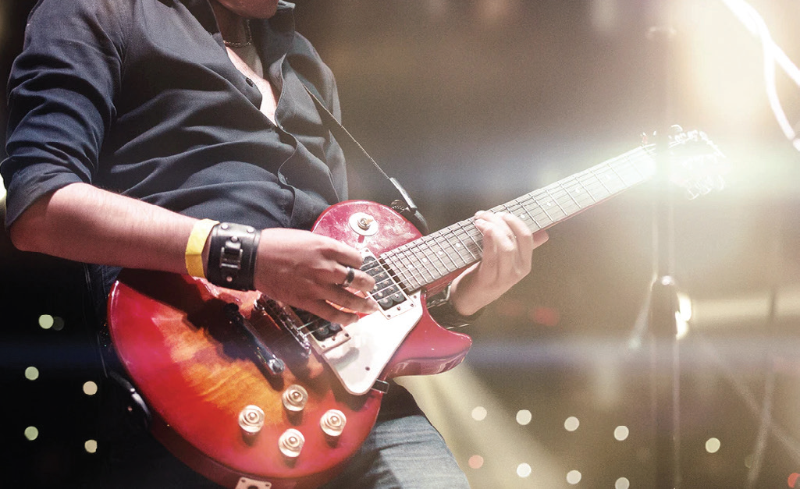Getting the right guitar tone is very tricky. The quest for the exact combination of guitars, pedals, amps, mics, tubes, strings, picks, pickups is the holy grail for most guitar players. On top of that there’s the necessity of finding the right relationship between the level of the amp, input gain, EQ settings – it’s a juggling act before that first note is even hit.
Guitarists: I’m fully aware that you want to have that “special tone” that’s in your head and coming from your amp faithfully translated through the PA system. With that in mind, here are some things you can do to make that happen with more transparency and with less stress.
Part Of The Whole
First, match sound levels very carefully. In the era of presets and stompboxes and modeling technology, the number of sounds a guitar player can make in one set is mind-blowing. Even when working with your own sound engineer, you still must be very careful when setting levels for each preset. The goal is to have seamless transitions between sections and punch through the mix in just the right places, instead of disappearing in the choruses and blasting everyone’s head off with blaringly loud solo patches.
Those level settings are not only dependent on your own levels, but on the arrangement of the song, so even if you’ve done some careful level matching, always double check your work in context of the performance. An effective way of doing this is by recording rehearsals and listening for anything that might disappear or pop out – multitrack recordings and virtual sound checks are the best option, but even a cell phone recording can reveal anomalies that you might not have heard on your own.
Second, please keep in mind that your sound doesn’t end with the amp. Unless it’s a small club without reinforcement, the sound is coming through the loudspeakers and wow, can it differ from what you are used to if listening to just the amp. Microphone selection and positioning are key in getting the right sound, but the rest of the signal chain can add even more noticeable difference.
I’ve had a fair share of guitar players listen to the solo guitar sound and complain that it’s different than what they’re hearing on stage. Let me share a little secret: it’s supposed to be. While guitarists are concerned with getting the fullest sound from their own rig, I’m concerned with shaping that sound in the context of the mix. This usually means shaving off the frequencies that might compete with other elements of the mix and create unpleasant notes when being reinforced.
So, if you’re listening to your channel during a virtual sound check, listen to it in the full context of the song, not just the context of “the sound in your head.” Depending on how busy the mix is, you might have to concede to some sonic disparities for the benefit of the big picture.
The Value Of Experience
One notable difference between guitarists who are “road tested” and those who may not be so well versed (at least yet) is the way they manage their stage levels. Experienced players usually know that they need to get their tone without compromising other band members sharing the stage.
There are several ways to do this. The obvious one is turning down the volume level. But that’s not always an option. I’m conscious of the fact that guitar tones are very dependent on the input gain and output volume of the amp, and the speakers in the cabinet speakers provide different saturation with high levels. That said, finding the lowest possible denominator of levels can be of great benefit to the overall mix and show.
If, however, levels are high because of monitoring issues, here’s something to try: direct the sound of the guitar cabinet directly at your ears and away from the audience. This may mean locating the amp on the side of the stage, raised, or tilted, so that the center of it (the speakers) is aimed directly at your head. It can also provide much better control over the tone as well since you’re hearing the entire frequency content, instead of the significant high-frequency cut that happens if the amp is right behind you, on the floor of the stage and aimed at your knees.
Another approach to try is aiming the amp away from the stage and the audience while requesting its sound be boosted in your monitors instead. It might differ from the amp sound, but you can get a bit more control in certain scenarios. It’s also worth experimenting with power soaks, iso boxes and guitar modelers – they can also be solutions for managing levels on stage.
Lost In Space
Finally, I want to touch upon the use of spatial effects. Guitar sounds can be quite dull without reverbs and delays, and players experiment with their spatial positioning all the time. The only caveat is that if you set a space that’s quite different from the tone of the song, it might be hard to place that tone in the context of the entire mix.
Even more problematic, overloading the sound with reverb will push it back in the mix and no knob on my console can bring you back from the depths of “the pit of early reflections,” making it impossible to make the sound more punchy or present.
My advice is finding a reasonable level that feels right and then dialing it back just one notch to accommodate for what happens during sound reinforcement. Also talk with the mix engineer and get their opinion. They might suggest changing the type of reverb or some minor setting adjustment that doesn’t affect the guitar sound greatly while helping it match more closely to what the mix needs to become an impactful, cohesive piece of art.
And as always, keep an open dialog with engineers. Ask questions about your sound, the mix, how it all fits together – anything relevant that comes to mind. That way you can gather valuable information and then decide what can be implemented into your sound, playing style, and anything else that might make you better at your craft.















